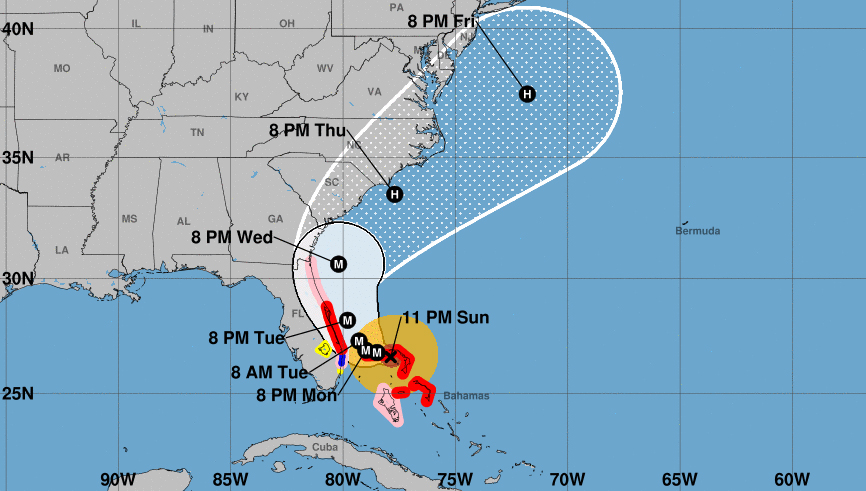Hurricane Dorian will not make landfall over the U.S., according to the official track forecast from the National Hurricane Center in its 11 p.m. advisory Sunday.
Yet Florida, Georgia, and the Carolinas remain at risk. The agency cautioned against focusing on the “exact track” and that a “small deviation to the left of the track could bring the intense core of the hurricane and its dangerous winds closer to or onto the Florida coast.”

Dorian has shown remarkable resiliency as it stayed a strong Category 5 hurricane with 185 miles per hour maximum sustained winds for most of the day, battering the northern Bahamas.
Bahamas Prime Minister Hubert Minnis said it was “probably the most sad and worst day of my life” during a press conference Sunday. He added, “We’re facing a hurricane … one that we’ve never seen in the history of the Bahamas.” Hazards facing the Bahamian islands for most of Sunday included wind gusts up to 220 mph and storm surge 18 to 23 feet above normal tide levels.
The storm is expected to slow down even more and weaken into Labor Day, but remain a major hurricane (at least Category 3) into at least Tuesday when the official NHC forecast puts it off the coast of Florida. The eye of the hurricane was roughly 140 miles east of West Palm Beach as of 11 p.m., moving at a sluggish 5 miles per hour.
Hurricane and Tropical Storm Warnings and Watches are already in effect for a long strip of the eastern Florida coast and into southern Georgia. The outer bands of Dorian have already reached Florida’s coast.
Hurricane Watches Expanded Northward Along the East Coast to the Florida/Georgia Border. Here are the 11 PM EDT 09/01 Key Messages for #Dorian. For more info see https://t.co/tW4KeFW0gB pic.twitter.com/CYtMosB5et
— National Hurricane Center (@NHC_Atlantic) September 2, 2019
With Dorian expected to start turning north in the coming hours, Florida, Georgia, and the Carolinas have declared states of emergency, and mandatory evacuations have been ordered in coastal areas stretching from Florida to South Carolina. President Trump approved an emergency declaration for the Sunshine State on Friday, freeing up resources and aid.
“The timing of the northwest or north turn is very critical in determining how close Dorian will get to the Florida peninsula on Tuesday and Wednesday,” the NHC said.
Storm surge, strong winds, flash flooding, and heavy rain all remain possible for these areas. By the end of the week, Dorian could still be a hurricane in the vicinity of Virginia, Maryland, and Delaware.
One more satellite loop of Hurricane Dorian now that it made another landfall in the Bahamas pic.twitter.com/WSVaViZnIh
— Joel Franco (@OfficialJoelF) September 2, 2019
Last week, Dorian became the fourth named storm and the second hurricane of the 2019 Atlantic hurricane season. It passed through the Virgin Islands and largely spared Puerto Rico, a U.S. territory that is still recovering from the devastation of the 2017 hurricane season.
Want to see more awesome imagery?
To see more photos 📸 and video 📹 from of #ReserveCitizenAirmen and Hurricane #Dorian. ✈️⛈🌪🌊 Click on the link at the comment below#ReserveReady #403WG #WC130J #SuperHercules #WeatherReady #NWSNHC @weatherchannel @NOAA pic.twitter.com/A9QBibRtnB
— Hurricane Hunters (@53rdWRS) September 1, 2019
Dorian has already broken multiple records after it rapidly intensified over the course of two days. It tied the record set by the Labor Day hurricane of 1935 in wind intensity when it made landfall over Bahamas on Sunday.
Trump described Dorian on Sunday as “one of the biggest hurricanes that we’ve ever seen.”





